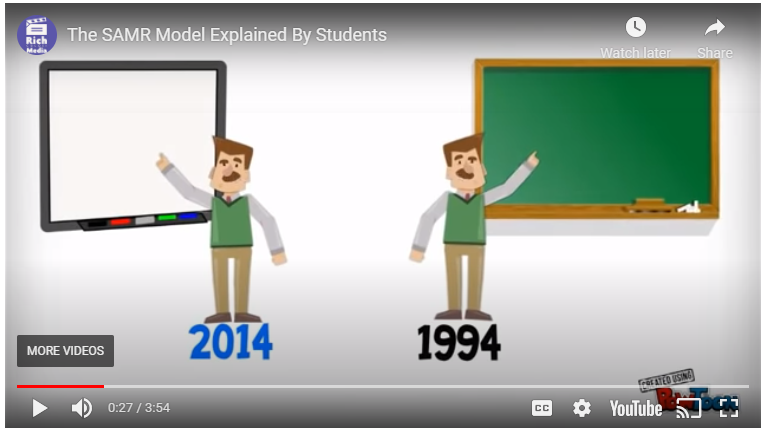There’s a certain sense, when you read or hear about SAMR, that it’s prescriptive. The authors of this week’s reading (The Substitution Augmentation Modification Redefinition (SAMR) Model: a Critical Review and Suggestions for its Use) rightfully point out that its presentation as a ladder seems to imply that the higher on the ladder you are with your learning object, the better. As they say, “Puentedura (2014b) communicates the belief that technology integration along the SAMR ladder leads to better results” (Hamilton et al, 2016). One video asks, “If we have today’s technology, why teach like we did 20 years ago?”, with the following illustration:

The same video uses the base example of the task of writing a persuasive essay. Following the SAMR steps:
- Substitution: Writing the essay with a pencil –> writing the essay with a word processor app.
- Augmentation: Writing the essay with a pencil –> writing the essay with Google Docs, with its spell and grammar checking, along with collaborative writing features.
- Modification: Writing the essay with a pencil –> writing the essay in a WordPress post with graphics and other media included, allowing comment-based conversations to occur after publishing to the world.
- Redefinition: Writing the essay with a pencil –> use digital storytelling software to create and publish a multimedia alternative to an essay.
While acknowledging that multimedia theories of learning would suggest that a message delivered simultaneously using both verbal and graphical elements is more effectively delivered to a recipient than a message with only text, there is plenty in the essay writing example to question. A selection:
- My child’s grade 4 class uses Chromebooks at school for much of their writing. Their facility with word processing is much better than mine was in grade 4. That said, their hand-writing is quite clearly worse off.
- The same class uses Google Docs’ features, including sharing. I too am using Google Docs for the purposes of collaborating with my EDCI337 group. This is current, relevant, authentic technology. It also means they are not learning in-person collaboration to the extent that I have.
- Modification + Redefinition: As described, here the task is changing. Depending on the audience, a blog post or digital story could be quite effective for persuasion. On the other hand, many avenues of life depend heavily on text-based rhetoric and show no signs of relenting (ex. much of academia, law, etc).
With the above, I’m hoping to establish that when processes change, so too do outcomes. Here’s where I find that SAMR needs to provide more clarity and guidance, and has the opportunity to re-position itself as an assessment tool rather than a prescriptive one. Hand-writing, in-person collaboration, and pure text continue to have relevance in our world. Indeed, we are constantly presented with multiple older and newer technological options for carrying out almost any task. When we consider changing a task to include different technology, we must consider what outcomes are gained/enhanced, and which ones are lost/weakened.
SAMR seems like an effective framework for analysis of changes – using it to categorize potential technology changes to a task facilitates identification of the effects of those changes on outcomes. The way that it is presented as a prescriptive tool seems to assume that newer technology is better, and this is where SAMR enthusiasts should take a step back and look at relevance. After all, returning to the graphic above, what is it really that a whiteboard offers that a chalk board does not?
And now, my edited goat video:
Leave a Reply
You must be logged in to post a comment.